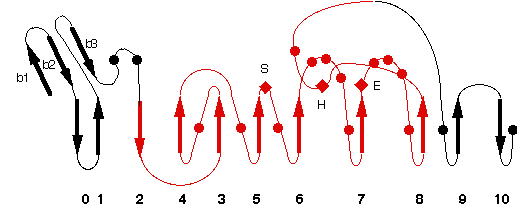1MX1
Name : Crystal Structure of Human Liver Carboxylesterase in complex with tacrine
Revelation date : 22-Apr-2003
Family : Carb_B_Chordata
Gene_locus : human-CES1
PDB file : ESTHER: header of PDB entry RCSB: Full entry
Comment
Ligand :
References (1)
| Title : Crystal structure of human carboxylesterase 1 complexed with the Alzheimer's drug tacrine: from binding promiscuity to selective inhibition - Bencharit_2003_Chem.Biol_10_341 |
| Author(s) : Bencharit S , Morton CL , Hyatt JL , Kuhn P , Danks MK , Potter PM , Redinbo MR |
| Ref : Chemical Biology , 10 :341 , 2003 |
| Abstract : Bencharit_2003_Chem.Biol_10_341 |
| ESTHER : Bencharit_2003_Chem.Biol_10_341 |
| PubMedSearch : Bencharit_2003_Chem.Biol_10_341 |
| PubMedID: 12725862 |
| Gene_locus related to this paper: human-CES1 |
Representative scheme of Prolylcarboxypeptidase structure and an image from PDBsum server

